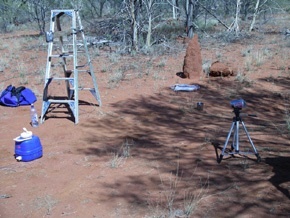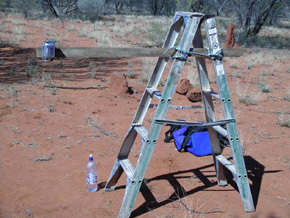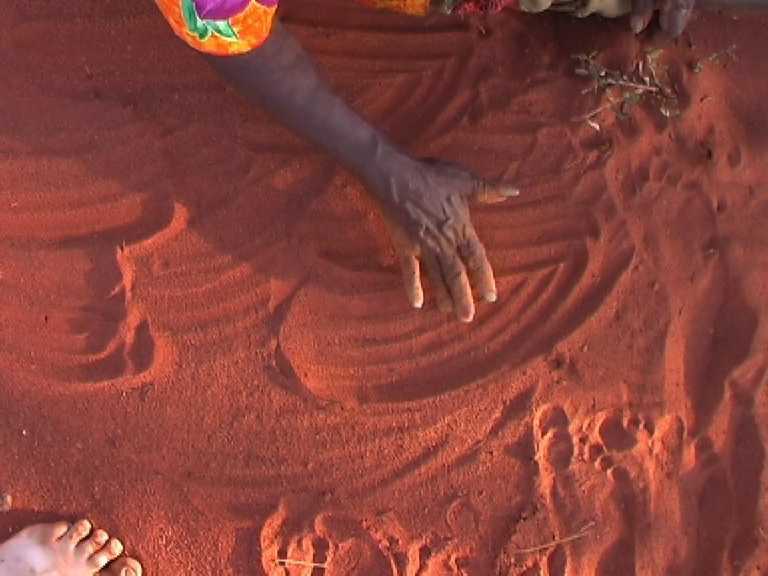In Central Australia, you often see Aboriginal people sitting on the ground, talking, and simultaneously drawing on the sand, smoothing it over when they’ve finished a point, and starting again. They might be recounting places along a journey, listing family members, drawing maps, or describing the movement of characters in a story. I’ll call this ‘sand talk’.
Here’s a child, Aileen, doing this in 1957 at the Bungalow school in Alice Springs. (Photograph by Joyce Gilbert, Picture Australia collection). And here’s a Central Australian man, Komita, drawing in the sand in 1940. (Photograph by Charles Mountford, Treloars Mountford Exhibition)
As characters move and scenes change, the narrator rubs out the picture in the sand and starts afresh. Jenny Green observes that there is a clear relationship between the iconicity of the sand drawings and the visual elements that are now used in marketable art from the Central Australian region. Scenes can be captured on canvas, and have led to the acclaimed Western Desert school of acrylic painting. The dynamic process of drawing, the motion, is harder to capture, although an attempt at this is seen in Warlpiri school readers – where the narrative unfolds page by page, each illustrated by a sequence of representations of sand drawings.
Sand pictures have attracted many ethnographers, from Nancy Munn’s classic discussion of the symbols used in such story-telling by the Warlpiri in the early 1950s [1], to the relations of sand stories to children’s literature and country (Jill McRae [2]), to art and country (Christine Watson [3]), to children’s perceptions of themselves (Ute Eickelkamp).
Linguists have become interested in sand talk – looking at how speakers use speech, gesture, sign, and drawing on sand in speech events ranging from mapping (David Nash [4]), to the unfolding of narratives (David Wilkins [5]). Now Jenny Green has embarked on a linguistics PhD project through Melbourne University to document sand talk among Arrernte, Alyawarr, Anmatyerre and Kaytetye people. She’s looking at, among other things, the timing and content of the different ‘modes’ of this multimodal art. Her early findings are that sand talk varies from something half-unconsciously done to a consciously composed art, and that there are a variety of distinct traditional forms as well as a lively contemporary practice.
Documenting sand talk requires filming (as Eickelkamp, McRae, Nash and Wilkins have done – and Joyce Hudson made a film of a Walmajarri woman telling a story using leaves on the ground [6]). But one camera alone can’t capture the complexity of sand talk. You need at least one camera to show the gestures and eye-gaze of the story-teller (more if it is a conversation), and you need one camera to show what’s happening on the sand. And of course good sound recording!
Jenny has come up with a terrific low-tech way of doing this.

One camera is on a tripod and takes a ‘front-on’ view of the narrator. The other camera is mounted on a beam across a step-ladder. This provides the birds-eye view for capturing the drawing.

She can just load the step-ladder and beam on the back of her utility truck when going out recording.
The birds’ eye view has the added advantage that you only see people’s hands, not their faces, and so provides optional anonymity if required.

And so some participants may be happy about having their hands or feet shown publicly whereas they would be less keen on having their faces shown. Ingenious, eh?
POSTSCRIPT: PIZZA-BOX SAND TALK
And, yes, some English story-tellers have taken up sand talk… you can find Richard Thompson’s description here of how to use cornmeal in a pizza-box with a glass bottom on an overhead projector to project sand stories….
REFERENCES
[1] Munn, Nancy. 1973. Walbiri iconography: graphic representation and cultural symbolism in a central Australian society. Ithaca, N.Y.: Cornell University Press.
[2] McRae, Jill. 1991. Story as sovereignty: a study of the relationship between the sand stories of the Warlpiri Aborigines and their country.: Kuring-gai studies in children’s literature no. 3. Sydney [Lindfield, N.S.W.]: University of Technology Sydney, Kuring-gai Campus, School of Teacher Education. [She created a video of the work in 1988].
[3] Watson, Christine. 2003. Piercing the ground: Balgo Women’s image making and relationship to country. Perth: Fremantle Arts Centre Press.
[4] Nash, David. 1998 ‘Ethnocartography: understanding central Australian geographic literacy’. Draft 2/10/1998, 30pp. Presented to Australian Anthropological Society annual conference, 2 October 1998, Canberra.
[5] Wilkins, David P. 1997. ‘Alternative representations of space: Arrernte narratives in sand and sign’, pp.133-162 in Proceedings of the CLS Opening Academic Year ’97-’98, ed. by M. Biemans & J.v.d. Weijer. Nijmegen [etc.]: Nijmegen/Tilburg Center for Language Studies
[6] The film was made with Joyce Hudson. I think it is Learning Chuguna’s Way [stories in Walmajarri & English]1988, with Mona Chuguna, 1988, Broome & Great Sandy Desert WA. (There’s a copy at AIATSIS).
 Follow
Follow
Brilliant, how cool is that?